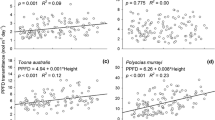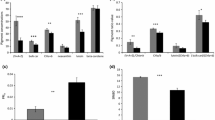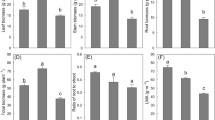Abstract
The functional roles of the contrasting morphologies of sun and shade shoots of the evergreen shrub Heteromeles arbutifolia were investigated in chaparral and understory habitats by applying a three-dimensional plant architecture simulation model, YPLANT. The simulations were shown to accurately predict the measured frequency distribution of photosynthetic photon flux density (PFD) on both the leaves and a horizontal surface in the open, and gave reasonably good agreement for the more complex light environment in the shade. The sun shoot architecture was orthotropic and characterized by steeply inclined (mean = 71o) leaves in a spiral phyllotaxy with short internodes. This architecture resulted in relatively low light absorption efficiencies (E A) for both diffuse and direct PFD, especially during the summer when solar elevation angles were high. Shade shoots were more plagiotropic with longer internodes and a pseudo-distichous phyllotaxis caused by bending of the petioles that positioned the leaves in a nearly horizontal plane (mean = 5o). This shade-shoot architecture resulted in higher E A values for both direct and diffuse PFD as compared to those of the sun shoots. Differences in E A between sun and shade shoots and between summer and winter were related to differences in projection efficiencies as determined by leaf and solar angles, and by differences in self shading resulting from leaf overlap. The leaves exhibited photosynthetic acclimation to the sun and the shade, with the sun leaves having higher photosynthetic capacities per unit area, higher leaf mass per unit area and lower respiration rates per unit area than shade leaves. Despite having 7 times greater available PFD, sun shoots absorbed only 3 times more and had daily carbon gains only double of those of shade shoots. Simulations showed that sun and shade plants performed similarly in the open light environment, but that shade shoots substantially outperformed sun shoots in the shade light environment. The shoot architecture observed in sun plants appears to achieve an efficient compromise between maximizing carbon gain while minimizing the time that the leaf surfaces are exposed to PFDs in excess of those required for light saturation of photosynthesis and therefore potentially photoinhibitory.
Similar content being viewed by others
Author information
Authors and Affiliations
Additional information
Received: 8 June 1997 / Accepted: 2 November 1997
Rights and permissions
About this article
Cite this article
Valladares, F., Pearcy, R. The functional ecology of shoot architecture in sun and shade plants of Heteromeles arbutifolia M. Roem., a Californian chaparral shrub. Oecologia 114, 1–10 (1998). https://doi.org/10.1007/s004420050413
Issue Date:
DOI: https://doi.org/10.1007/s004420050413




